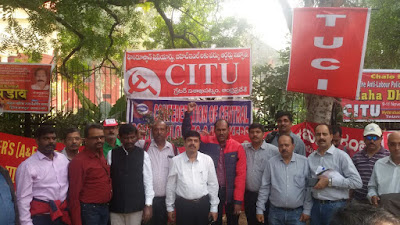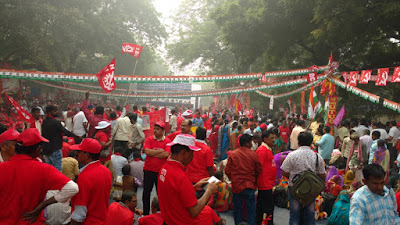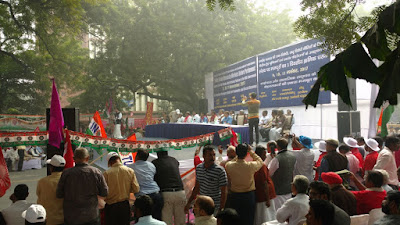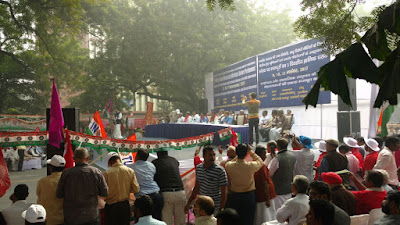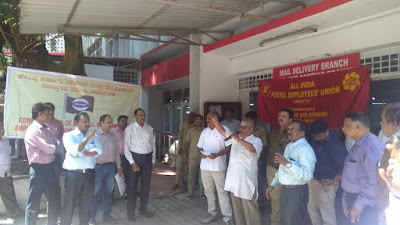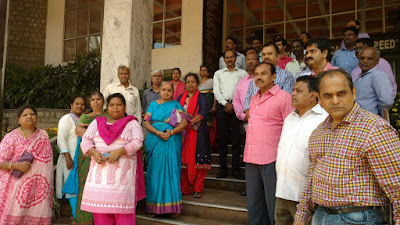The concept of
the Need-Based Minimum Wage has evolved in India after Independence and owes its origin to the Directive Principles of the Indian
Constitution and the welfare policy of the Government. Its acceptance in
principle connotes a public effort at an institutional determination of wage
rates particularly in the industrial sector of the economy. Unfortunately the
computation of the need based minimum wage has become a controversial subject
in the country. While the concept of what the need based minimum wage should
cover is fairly clear and generally accepted by both the employer and employee,
its actual assessment into monetary terms has raised endless disputes not alone
by the employer.
NEED-BASED
MINIMUM WAGE FORMULA:
Minimum wages
for the average family will have to be based on requirements of food, clothing,
housing and so on. Additional components of expenditure to cover for children’s
education, medical treatment, recreation, festivals and ceremonies.
In a vast country
such as ours, there are bound to be regional variations in these requirements
owing to climatic conditions, food habits, etc. At the same time in order to
ensure a degree of uniformity the Conference have adopted a certain norms. The
food component carries the largest- proportion of the total cost of living in a
working class family. The component’s significance is not only economic but
human also. On food depends the health and efficiency of the worker, which is
vital to the industrial production. After a protracted discussion the
Conference adopted Dr. Aykroyd’s second dietary prescription of the adequate
diet level, the other one being the optimum diet level. An optimum diet
according to him, is one which ensures the functioning of the various life processes
at their very best; whereas an adequate diet maintains these processes but not
at their peak levels. The optimum diet would include more of vitamins and less
of proteins in its caloric content, while the adequate diet would include more
of proteins and less of vitamins.
The Committee on
Fair Wages laid down that the standard working class family should be reckoned
as one consisting of three consumption units, supported by a single male earner
and including his wife and two children below the of age 14 The 15th Session of
Indian Labour Conference approved that the wage should cover four categories of
needs considered essential for the worker's well being, viz. food, clothing,
housing and miscellaneous. In calculating the minimum wage, the norms for the
food category should be based on Dr. W.B. Aykroyd’s formula for an adequate and
balanced diet. It thus came about that a wage linked to the needs was suggested
as a desirable minimum.
Subsequently,
when attempting to implement the recommendations of the conference, almost all
the wage fixing authorities including the committees appointed under the
Minimum Wages Act, 1948 have invariably faced difficulty in determining: (i)
the calorific norm which should form the basis of the diet content (ii) the
exact composition of the diet (iii) the qualities of the various items of diet
and (iv) availabilities of food commodities consumed by the worker and his
pattern of consumption. In this regard the first assault was launched by the II
Central Pay Commission (1959), pertaining to the calorific norm as laid down by
the 15th Indian Labour Conference. The Indian Labour Conference worked out the
three-unit formula, the minimum wage is worked out taking into consideration
the calorific value requirements of 2,700 each, certain length of cloth
requirement, housing rental value, education and medical expenses etc.
CONCEPT OF LIVING
WAGES:
Concept of Living Wages It represents a standard of living which
provides not merely for bare physical subsistence but for maintenance of health
and decency, a measure of frugal comfort, including education of children,
requirement of essential social needs and a measure of insurance against eh
more important misfortunes including old age. This is the ideal wages and
envisaged in Article 43 of Directive Principles in Part IV of the Constitution.
I. L. O. Conventions also provide for living wages.
Living wages is the ideal wages and on the line as stipulated in Article
43 of our Constitution. Wage differentials are necessary part of wage structure
if skill formation is to be motivated and productivity is to be achieved but at
the same time it should be reasonable.
Hence it is relevant to quote the following observation made by the
Kerala High Court in Association of Planters of Kerala v State of Kerala in
this regard: “ A failure to fix or revise minimum wages was not only a
statutory violation but is a breach of fundamental right enshrined in Art. 23
of the Constitution. A duty is cast upon the State by provisions of the Act and
Article 23 to fix and revise the minimum rates of wages.
7th CPC
REPORT PARA NO 4 HAS ALSO DEALT THE ISSUE OF A NEED-BASED MINIMUM WAGE
TAKING INTO THE CONCEPT OF THE FOLLOWING.
a). normative
family is taken to consist of a spouse and two children below the age of 14.
With the husband assigned 1 unit, wife, 0.8 unit and two children, 0.6
units each, the minimum wage needs to address 3 consumption units;
b) . The food requirement per consumption unit is shown in the Annexure
to this chapter. The specifications were derived from the recommendations of
Dr. Wallace Aykroyd, the noted nutritionist, which stated that an average
Indian adult engaged in moderate activity should, on a daily basis,
consume 2,700 calories comprising 65 grams of protein and around 45-60 grams
of fat. Dr Aykroyd had further pointed out that animal proteins, such as milk,
eggs, fish, liver and meat, are biologically more efficient than vegetable
proteins and suggested that they should form at least one-fifth of the total
protein intake
c) The clothing requirements should be based on per capita
consumption of 18 yards per annum, which gives 72 yards per annum (5.5 meters
per month) for the average worker’s family. The 15th ILC also specified the
associated consumption of detergents
d) The prescribed provision of Report of the Seventh CPC 63Index 25
percent to cover education, recreation, ceremonies, festivals and medical
expenses has been reduced to 15 percent.
THE THREE-UNIT
BASED FORMULA ADOPTED BY THE PAY COMMISSIONS NEEDS A CHANGE TO SIX UNITS DUE TO
FOLLOWING FACTORS :
The three-unit
based formula to fix minimum wages presently counts only four members of a
family ie husband, wife and two children. It has no provision to count
dependent parents, if any, or even if there are more than two children.
The three-unit
formula gives the husband a full unit, wife 0.8 unit, and 0.6 units for each of
the two children.
Now the trade
unions and the employees associations are of the opinion that the
three-unit system are not sufficient to decide minimum wages because the
children continue to stay with the family for longer periods. The two children
and wife should be accorded one single unit instead of 0.6 units,” also,
marriageable age of a child has also increased and they should also be given
full units, the gender equality should also be observed instead of 0.8 units it
should be full unit for the spouse.
Hence should be
revised to the four unit formula gives the husband a full unit, wife full unit,
and full units for each of the two children.
After the 2010
Supreme Court ruling that dependent parents are to be taken care of by
children, two more units should be added and the formula be based on six-unit
formulae than three.
“The CrPC
section 125 and Maintenance of Parents and Senior Citizens Act make it
mandatory for an earning member to maintain his parents, failing which he/she
may have to face penal consequences. Today, the average life span of a person
has increased to 68.3 years compared to that of 41 years in 1957. Hence two
additional units have to be added,”
So there
is a need to hike number of units from three to six to calculate minimum wages.
OTHER FACTORS
AFFECTING OUR WAGES ARE AS FOLLOWS:
1) The 7th CPC
has taken into consideration the 15% to cover education, recreation,
ceremonies, festivals and medical expenses against 25% prescribed by the
Supreme Court . Additional components of expenditure to cover for
children’s education, medical treatment, recreation, festivals and ceremonies.
This followed from the Supreme Court’s ruling in the Raptakos Brett Vs
Workmencase of 1991 for determination of minimum wage of an industrial
worker. The Supreme Court had prescribed this amount at 25 percent of the total
minimum wage calculated from the first five components.
2) Secondly
the prices of essential commodities for calculation of the minimum wage is
always a debate , the price essential commodities by the using Consumer
Price Index for Industrial Workers maintained by Labour Bureau, Shimla and the
retail prices are showing different rates , the retail prices of essential
commodities are at higher end including that of state
Government run co-operative society’s compared to the retail
prices maintained by Labour Bureau, Shimla by more than 15%, that is
the prices maintained by Labour Bureau, Shimla are lower by more than 15%
compared to market prices , the CG employees are deprived of proper minimum
wage by an extent of 25% . If proper retail prices are taken into
account the minimum wage shall be more than Rs 26,000/- as on 1st Jan
2016.
THE PAYMENT OF WAGES
ACT, 1936:
The revision of payment of wages
act, 1936 , the Government has raised the monetary limit of wages to Rs.
24000/- per month for the applicability of the Act by issuing the notification
.This calculation of Rs 24,000/ is based on Dr. W.B. Aykroyd’s formula. This is done on the basis of figures of
the Consumer Expenditure Survey published by the National Sample Survey
Organization.
The payment of wages act, 1936 monetary limit of wages to Rs. 24000/- per month is
for unskilled worker , if we add Rs 25% for skilled worker , it work out at Rs
30000/- for skilled worker which includes wages and allowances, at present the
Central Government employees at the initial stage are paid Rs
23,000/- (Rs 18,000/ as minimum wage and Rs 5,000/ as allowances ), still there
is gap of Rs 7,000/ , if the minimum wage of Central Government employees is re
fixed at Rs 22,000/ then this gap shall be reduced.
The breakup of the Central Government employee’s
salary is as follows.
Non Metro City
Minimum wage Rs 18,000/-
HRA Rs 1800/-
Transport allowances Rs 900/-
Children education allowances Rs 2250/-
Total Salary : Rs 22950/-
The Central Government employees are deprived of the actual minimum wage
of Rs 26,000/-. Hence there is a need of revision of minimum wage from Rs
18,000/ as Central Government is a model employer.
Issued by COC Karnataka
